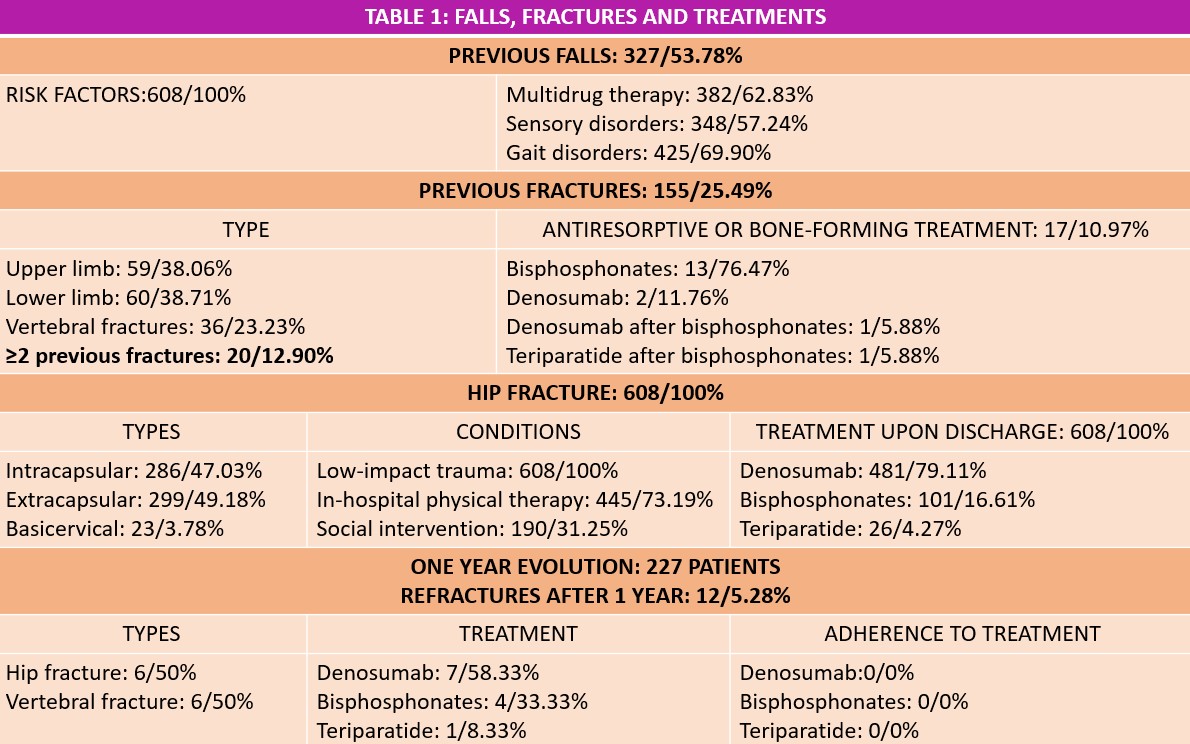Session Information
Date: Monday, November 18, 2024
Title: Osteoporosis & Metabolic Bone Disease – Basic & Clinical Science Poster
Session Type: Poster Session C
Session Time: 10:30AM-12:30PM
Background/Purpose: Osteoporosis is a common disease of the elderly patient. It is often under-diagnosed and is known with the onset of fragility fracture. Furthermore, despite subsequent treatment, fractures sometimes continue to occur.
The aim of the study is to describe the clinical characteristics and the evolution during the first year of a cohort of elderly patients after suffering an osteoporotic hip fracture.
Methods: An observational, descriptive, prospective longitudinal study was conducted by analyzing fractures and previous treatments, hip fracture and evolution at one year of 608 elderly patients hospitalised in 2022 and 2023 for hip fracture from discharge from the process until February 2024. Statistical analysis was performed using SPSS software.
Results: The average age of the patients was 87.28 years, with a range of 62-102 years and a predominance of women (455).
The characteristics of the hip fractures are summarized in Table 1. All were caused by low-impact trauma and all patients had at least one risk factor for falls according to the Downton scale.
Prior to their hip fracture, 155 patients had suffered a previous low-impact fracture. The most frequent was at the level of the lower limb (60). More than one previous fracture was found in 20 cases. However, only 17 had received antiresorptive or osteoforming treatment (table 1).
After the hip fracture, anti-osteoporotic treatment was prescribed to all patients. The most frequently used being denosumab (481).
227 patients would have completed one year of hip fracture evolution. In 12 cases a new fragility fracture due to falls appeared. These 12 patients presented a total lack of adherence to the prescribed anti-osteoporotic treatment.
Conclusion: -Falls are a high-risk geriatric syndrome for the elderly.
-Osteoporosis continues to be an under-diagnosed disease whose first manifestation in the form of a fracture conditions the prognosis of patients’ lives.
-Adherence to anti-osteoporotic treatment is insufficient. Long-term follow-up is required to monitor adherence to anti-osteoporotic treatment and avoid refractures.
To cite this abstract in AMA style:
Miguel Ibáñez B, Pablos Hernández C, Ibáñez Martínez M, Chacón Vélez C, Blanco Ramis L, Cimadevila Santiago S, Martínez González O, Turrión Nieves A, Martín Martínez M, Hidalgo Calleja C, Montilla Morales C, Compán Fernández O, Lorenzo Rodríguez L, Hernández Madrid J, Gómez Castro S, Blanco Blanco J, González Ramírez A. Primary and Secondary Prevention of Osteoporotic Fracture in the Elderly Patients [abstract]. Arthritis Rheumatol. 2024; 76 (suppl 9). https://acrabstracts.org/abstract/primary-and-secondary-prevention-of-osteoporotic-fracture-in-the-elderly-patients/. Accessed .« Back to ACR Convergence 2024
ACR Meeting Abstracts - https://acrabstracts.org/abstract/primary-and-secondary-prevention-of-osteoporotic-fracture-in-the-elderly-patients/

